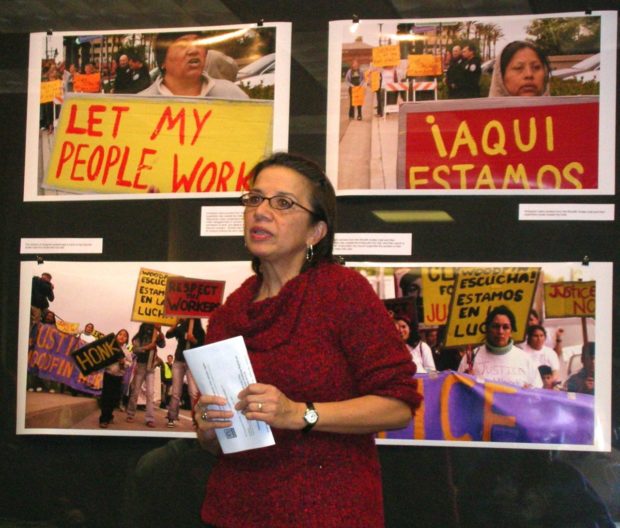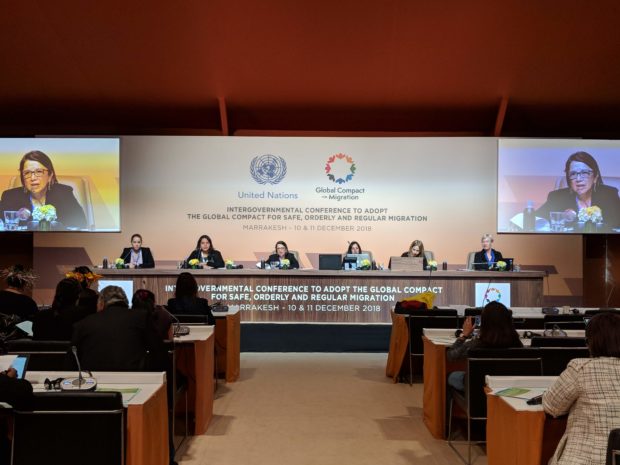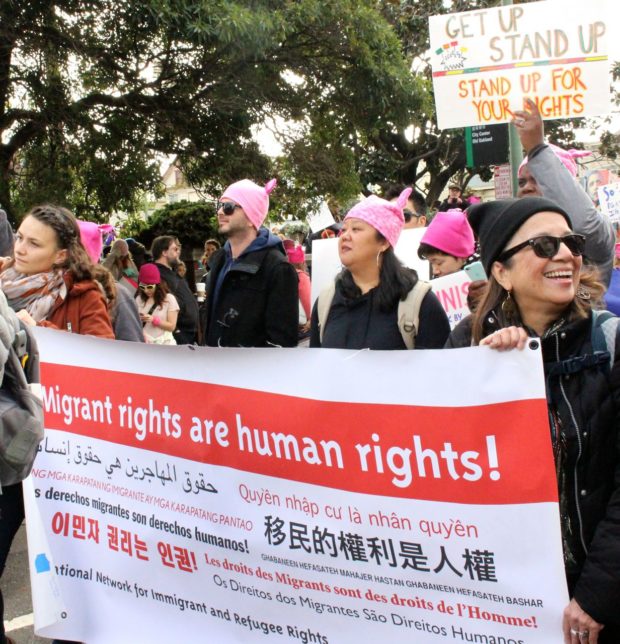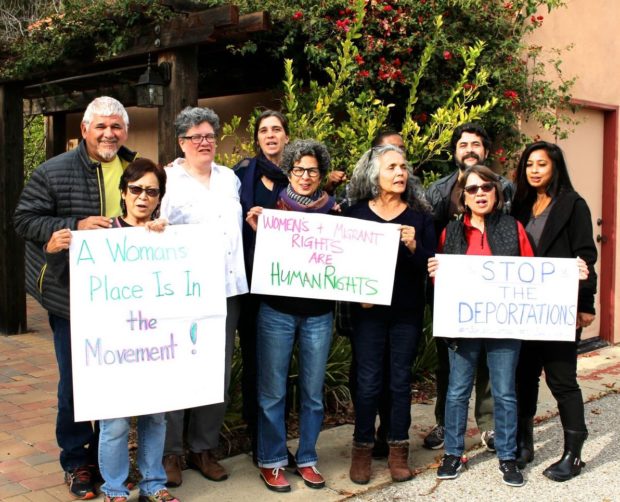Fil-Am global immigrant rights advocate steps down after 30-year service

Since 1986, Tactaquin has led the National Network for Immigration Rights based in Oakland, California. CONTRIBUTED
OAKLAND, California — You won’t see Cathi Tactaquin’s photos plastered in Filipino American publications in traditional or social media. She is not among the usual figures that make grand entrances back-slapping with the wealthy and powerful. That’s just not how she rolls.
Where she stands out is on the streets, waving banners and signs in solidarity with the exploited and marginalized, or on international panels demanding equity.
Unless you’re a global activist, community organizer, social justice advocate or a student of Filipino American history, you may not be familiar with her name. But you would certainly be witnessing the consequences of her life’s work nevertheless.
Since the mid-1980s, the executive director of National Network for Immigrant and Refugee Rights (NNIRR) has worn wings on her feet developing strategies to effect fair and humane immigration policies around the world.

Cathi Tactaquin (center) moderates 2018 Intergovernmental Conference to Adopt the Global Compact for Safe, Orderly and Regular Migration in Marrakesh. CONTRIBUTED
She co-founded the Oakland-based organization with a multisectoral group of allies that had campaigned for immigration reform and influenced the Immigration & Control Act of 1986 (IRCA).
Radical changes resulted, most importantly the legalization of millions of the undocumented. On the downside, IRCA also criminalized undocumented immigrant workers and militarized the southern border, redoubling the activists’ incentives to mobilize globally and organize formally.
This month Tactaquin is stepping down from the post she held for three decades. She has no immediate plans, she told INQUIRER.NET, echoing community service lifers’ refrain that she’s “leaving the job but not the movement,” keeping her options open on the “many ways to help contribute to positive change.”
She won’t fade away into the sunset.
Two months ago, invitations began circulating for a gratitude party to honor Tactaquin’s “leadership and commitment” from those who’ve soldiered on with her as students and then as changemakers.
The three-hour celebration June 15 at the Ed Roberts Campus Atrium in Berkeley will reunite the honoree’s colleagues Elizabeth Cabraser, David Chiu, Paula Collins, Bill Hing, Bob Hirsch, Eva Paterson, Brad Seligman, Cheryl Stevens, and Bill Tamayo, otherwise known that evening as The Coolerators band. They will be joined by Black Alliance for Immigrant Justice founder Gerold Lenior, NNIRR board members from South Texas Human Right Center and La Coalicion de Derechos Humanos Eduardo Canalas and Isabel Garcia, Global Coalition on Migration leader Monami Maulik, Carol Barton, comedian Nato Green and the Ben Luis Band at the tribute that will benefit Tactaquin’s erstwhile home organization.

Amid pussy hats, NNIRR chief leads women’s march. CONTRIBUTED
Engineering the celebration is fellow California-born Lillian Galedo, Tactaquin’s sister in arms. They first met at the Filipino People’s Far West Convention in Berkeley in 1975, a telling moment for Galedo, herself a lifelong community activist.
“She was facilitator and MC for the assembly session of a two-day conference of over 200 attendees,” Galedo remembers the woman at the center of a decisive point in the Filipino American identity movement. “Not an easy assignment given that the audience of young people – some as young as 12 years – was at times distracted by the freedom of being away from home. She managed well, keeping the discussion at a high level. She was probably 22 years old at the time. I was very impressed.”
They bonded over the course of their convergent passions and similar origins.
“We started NaFIRO (National Filipino Immigrant Rights Organization) then CDIRR (Committee to Defend Immigrant & Refugee Rights) a couple of years later, as the national debate on immigration reform was heating up, and the INS (Immigration & Naturalization Service, precursor of Homeland Security) was aggressively conducting raids. NaFIRO was directed to organizing the Filipino community. CDIRR was directed to organizing the broader immigrant rights community in the San Francisco Bay Area,” Galedo traces the root of their alliance that began with their common opposition to the Marcos dictatorship in protest against its atrocities on Filipinos on both sides of the Pacific.
“In the mid-1980s – along with a strong core of national immigrant rights leaders – we started the National Network for Immigrant & Refugee Rights. She was not the first ED, but she has been the ED for 30 of the Network’s 33 years. She has been the anchor of NNIRR that made it possible for it to continue to this day to fight the immigrant rights fight,” says Galedo, who served over 30 years as executive director Filipino Advocates for Justice, formerly known as Filipinos for Affirmative Action.
For most of the headliners at the June 15 party, directly experiencing inequity was the fount of their activism.
“As a youth I was aware of my own family’s difficult circumstances – my father was a farmworker and we grew up in the Salinas Valley, without many resources. But (I) did not really understand the bigger context of class and race – of history – until I went to college, ” Tactaquin shares her chosen path.
Catherine Tactaquin was the only daughter of the four children of Rodrigo Rivera Tactaquin, who came to the US from Sual, Pangasinan, in 1927 to work as a farmworker, and Ruby Sharp Tactaquin, an Oklahoma native her daughter describes as English, French, Cherokee, Chickasaw, and Choctaw.
Cathi and her three brothers grew up in Buena Vista in the country’s Salad Bowl. She attended elementary through high school 10 miles away in Salinas.
She has always been forthright about her beginnings as a “farmworker family” with limited resources, counting her fortune to “receive financial aid and scholarships to attend UC Santa Cruz and UC Berkeley.”
While many of her contemporaries in San Francisco turned to hallucinogens to escape the conflict simmering in the Pacific with the deployment of the first US troops in Vietnam, Tactaquin dived deep in the discourse around the impact of the war on the land both of her birth and her ancestry. She found herself, discovered her rich heritage and a calling.
“That was in the 1970s and like many other Filipino Americans, I was exposed to the range of issues of the day – the Vietnam war and what was taking place in Southeast Asia, and how the Philippines was connected as a US military staging ground,” she recalls. “And the rise of ethnic studies. One of my professors at UC Santa Cruz even held a little study group on Philippine history as there was no class offered – held in my dorm room! I was made aware of organizing among young Filipinos in the Bay Area when organizers from the International Hotel struggle came to the campus to speak; I remember Pete Almazol in particular – and I later worked for him in Filipino Immigrant Services (FIS) in Oakland.” (FIS was a program of Filipinos for Affirmative Action, the early incorporated name of Filipino Advocates for Justice, Judith Olaes, longtime administrative assistant at the Oakland nonprofit, told INQUIRER.NET.)
For her senior year she transferred to UC Berkeley where her budding activism eventually blossomed.
“I became involved in the National Committee for the Restoration of Civil Liberties in the Philippines, and the Union of Democratic Filipinos (KDP). I had been a community studies major in college and for me, activism in the Filipino community was a natural progression.”
The progressive KDP further opened her consciousness to the injustice confronting immigrants.
“I was working on issues of employment discrimination and it had become apparent that much of the discrimination cases had to do with immigration status or being recent immigrants – language discrimination, for example, or non-recognition of credentials, or just plain racial discrimination. At FIS I was placing Philippine lawyers into parking lot attendant jobs!”

At NNIRR planning retreat: Eddie Canalas, Lillian Galedo, Monica Hernandez, Jennifer Ferrigno, Susan Alva, Isabel Garcia, Janice Rosheuvel, Pancho Argüelles Paz y Puente, Cathi Tactaquin and Monami Maulik. CONTRIBUTED
By then newcomers were surging from across the Pacific and south of the United States as a result of the 1965 Hart-Celler Act, which repealed the 1925 law restricting immigration to the National Origins Formula favoring Northern and Western Europeans. The arrival of immigrants from Asian, Latin American and Mexico triggered calls for massive deportations and clamor for changes anew to immigration law.
Through KDP and their counterparts from Mexico, El Salvador and Haiti, Tactaquin plunged headlong in organizing on immigration and refugee issues. Passage of the Simpson-Mazzoli bill in the 1980s “catalyzed” the activists into building their coalition from which the National Network for Immigrant and Refugee Rights flowered in 1986.
Layers of socio-political transitions inspired Tactaquin, who explains the heart of her dedication: “My own family’s experience and the backdrop of a rise of activism and awareness raising on issues of race during the 1970s that contributed to shaping my commitment – and being fortunate to connect with organizations that consciously organized in communities and sought to change public awareness.”
Transforming a state of adversity to advocacy takes work, Tactaquin concedes. “We can’t assume that children will grow up to be exposed to or ‘learn’ social justice.”
While she agrees that parents have the “unique opportunity to provide the guidance and opportunities for children to learn to be a positive influence with their friends, in their schools, in their communities,” she cautions that “you can’t force children to be social justice activists, but you can lay the foundation for them to appreciate humane values and the need for social justice.”
Now the mentor, she shares her wisdom and lessons learned from tried and tested tactics.
“Particularly in more recent years, I have found young activists who are very knowledgeable, committed and eager to grow and make contributions. But they often lack connections to organizations that can provide options for collective engagement and growth. And some may only be engaging through social media, or through mobilizations. They need access to democratic organizations that appreciate and engage in grassroots organizing, as well as serious consideration of policy change. I also encourage young folks to work intersectionally – to grapple with related issues, for example, of immigration and climate change, or health, or workplace issues.”
The Fil-Am who has helped form and steer organizations such as Migrant Rights International based in Geneva and Poverty, Race and Research Action Council in Washington, DC, was selected as the Grand Rapporteur for the UN’s Interactive Dialogue on Migration and Development in 2013.
She spoke on behalf of global civil society at the UN’s High Level Dialogue on International Migration and Development. Last year she moderated the2018 Intergovernmental Conference to Adopt the Global Compact for Safe, Orderly and Regular Migration in Marrakesh.
On her watch, NNIRR has been a leading force for immigration reform policies and practices. In 2009, it issued an open letter to President Obama endorsed by over 3,500 individuals and organizations from 49 states and the District of Columbia, urging swift action to implement principles for fair, just and human immigration reform. It published reports and resources to facilitate community education and organization on the issue. The effort has always been collegial, Tactaquin emphasizes.
“I’m proud that the organization has been steadfast in defending the rights of the undocumented, especially at a time when many in our immigrant rights movement were not prepared to do so because it was viewed as ‘too left’ and not fundable. Fortunately, things have changed but I’d like to think that our role and that of some other groups who continued to promote human rights for ALL immigrants pushed the movement along,” she says, downplaying her personal contributions.
“We helped to pioneer ‘popular education’ strategies and training within the movement, through BRIDGE – Building a Race and Immigration Dialogue in the Global Economy – which contributed to the training of thousands of activists. And we helped to build up the international migrant rights movement, playing pivotal roles in groups like Migrants Rights International, the Global Coalition on Migration, and the Women in Migration Network. We have been involved in the global movement since the mid-1990s and continue to participate in its critical evolution.”
Quite a track record for someone who identifies simply as “an activist for social change, a mother and partner, good friend.”
Galedo knows all that for a fact and more, hailing Tactaquin as a “respected leader globally and internationally for her strategic vision, and coalition building and collaboration skills.”
“She’s a mentor to thousands of immigrant and migrant rights activists from the Asian, African, Latino, and South Asian communities here in the US and internationally. She’s grounded in human rights and understands the intersectionality of the immigrant rights issue: its connection to the anti-racist struggle, to equal labor rights for all workers – regardless of status – to the root causes of migration, including climate change.”
If there’s anyone who can empathize with Tactaquin’s decision to move on from NNIRR, it’s Galedo, who became Filipinos for Affirmative Action Executive Director in 1983 and headed the agency until 2017, when the agency changed its name to Filipino Advocates for Justice.
Like Tactaquin, Galedo is no stranger to “working non-stop for 30-plus years in an intense arena with extreme challenges, and scant resources.”
“She deserves a break and a change,” says Galedo, who remains a force in the resistance movement though officially retired. “I’m sure we haven’t see the last of her. She’s done a great job establishing the Network’s human rights framework, and a broad network of organizations who will carry on the work. Her legacy is clear and well respected.”

